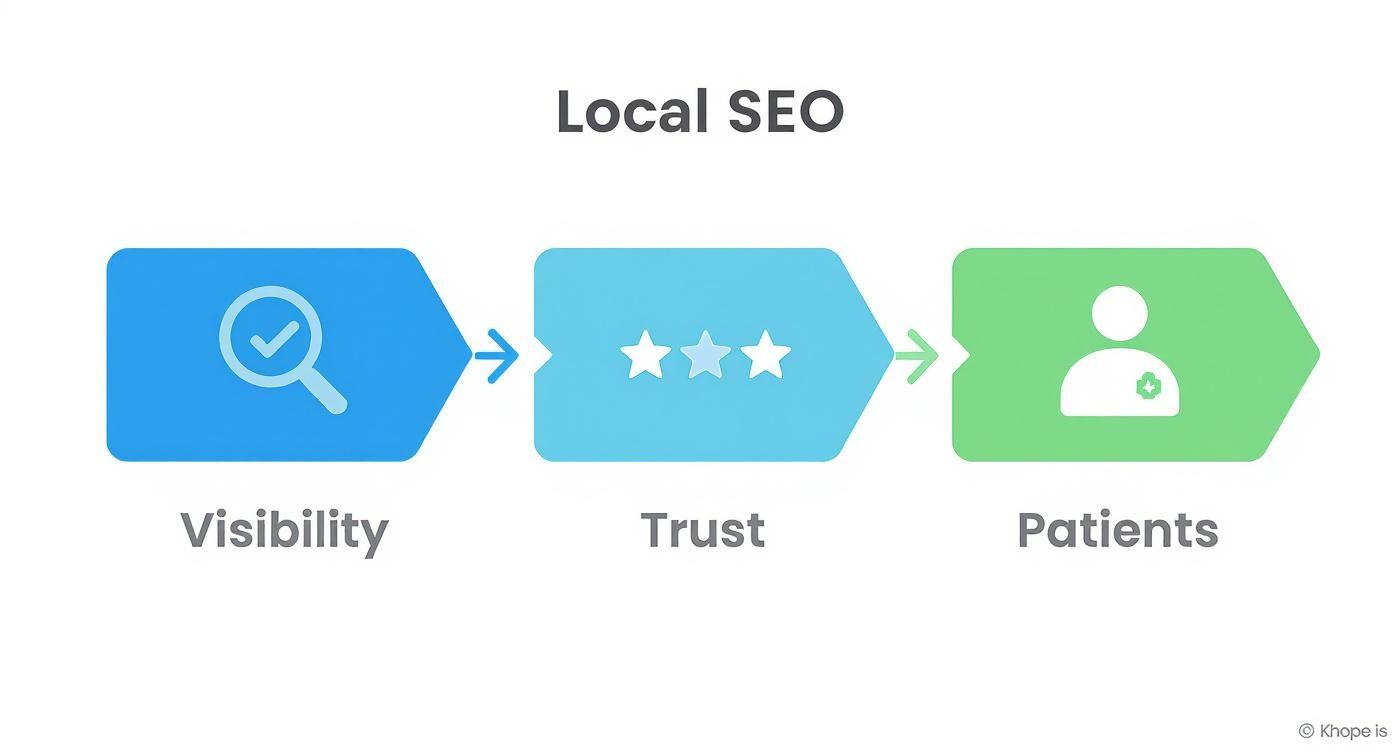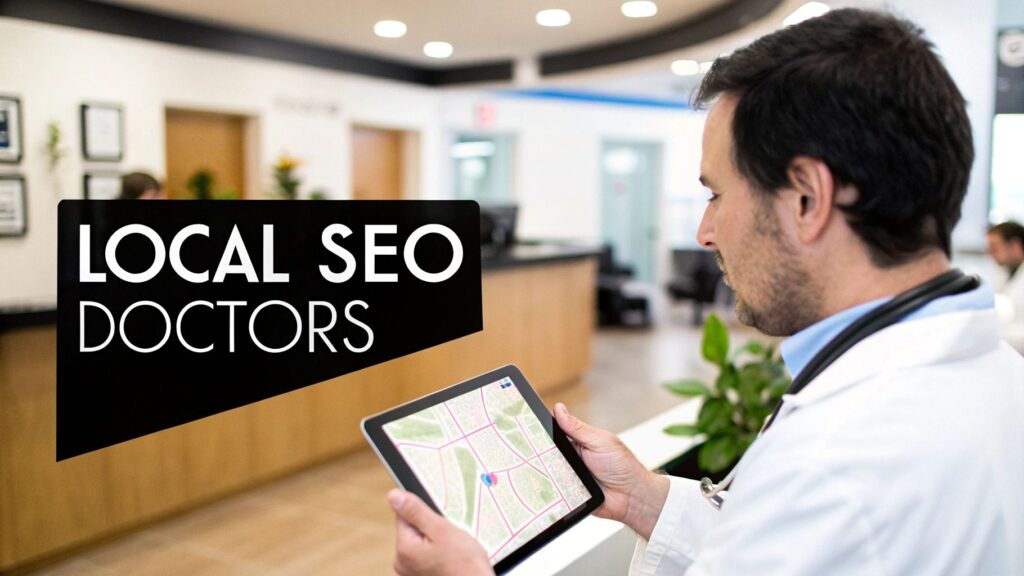When people look for a new doctor, they don't ask a neighbor anymore—they ask Google. Their search usually starts with something like "best dermatologist near me" or "pediatrician in Austin."
If your practice shows up right there, you start building trust immediately. It's all about being visible when a potential patient needs you most.
In Short: A solid local SEO strategy connects your practice with patients in your community who are actively searching for care.
Why Local SEO is Essential for Medical Practices
Your digital front door is just as important as your physical one. When a health concern comes up, people grab their phones and search. If your practice isn't in those top local results, you're invisible.
This is why a strong local SEO for doctors strategy is non-negotiable. It’s not about technical jargon; it’s about connecting with people in your community when they need care.
Meeting Patients Where They Are Searching
Think about the last time you needed a local service. You likely used Google, looked at the map, and checked reviews. Your patients do the same thing. A good local SEO plan puts your practice front and-center at that critical moment.
The benefits are clear:
- Get Seen: Your practice appears in local search results and on Google Maps.
- Build Trust: A complete profile with positive reviews tells patients you're reliable.
- Book More Appointments: More visibility and trust lead to more calls and website clicks.
This shows how online visibility turns into a new patient for your clinic.

It's a simple path: get found online, earn trust, and welcome new patients.
What is the Google "Map Pack" and Why Does it Matter?
For any local practice, the Google Map Pack—the box showing the top three local results—is the most valuable digital real estate. Data shows that 83% of people use search engines to find local healthcare providers.
Getting into that Map Pack is a game-changer. A huge 42% of users click on one of those top three listings. If you're there, you get the majority of clicks that become appointments.
For doctors, competition is hyperlocal. You’re competing with the practice down the street, not one in another state. This is where a focused local SEO strategy provides a major advantage. Our guide on dominating local maps SEO explains how to win this crucial digital ground.
It's about making sure that when a local patient needs care, your name is the first one they see.
Top 3 Local SEO Priorities for Doctors
If you're just starting, focus on these three areas for the biggest impact.
- Google Business Profile: This is your digital storefront on Google. It's the first impression a patient gets. Your first step is to claim and completely fill out every single section.
- Patient Reviews: Reviews are the new word-of-mouth. Patients trust them. Set up a simple system to ask every patient for a review after their visit.
- Website "On-Page" SEO: Your website must clearly tell Google and patients who you are and what you do. Make sure your name, address, and phone number (NAP) are on every page.
Nailing these three things will put you far ahead of the competition.
Your Google Business Profile: The New Front Door
Before a patient ever visits your office, they've already "visited" you online. That first visit almost always happens on your Google Business Profile (GBP). This makes it the cornerstone of your local SEO for doctors.
Your GBP is your first impression. A well-managed profile makes a patient feel confident. An empty or outdated one might send them to the next doctor on the list.
Go Beyond Your Name and Address
Just claiming your profile isn't enough. The real value comes from filling out every section with details that patients care about. This means going beyond the basic Name, Address, and Phone number (NAP).
This is your chance to answer patient questions before they even ask.
Here is the Google Business Profile dashboard. This is where you control how your practice appears on Google Search and Maps.
Getting familiar with this dashboard is the first step to winning over new patients.
Key GBP Sections to Focus On
To turn your profile into a patient-attracting tool, pay attention to a few key areas. Each one is a chance to provide value.
List Your Specific Medical Services
Don't use a broad category like "Family Medicine." People search for specific solutions.
- Think like a patient: List services like "Telehealth Consultations," "Annual Sports Physicals," "Allergy Testing," or "Minor Surgical Procedures."
- Why it works: When someone searches for "sports physicals near me," having that service listed on your profile tells Google you're a great match.
Use Real Photos and Videos
Stock photos feel impersonal. Patients want to see the real people and space they'll be visiting.
Use your smartphone to take high-quality, authentic pictures of:
- Your front-desk staff
- The doctors and nurses
- Your waiting room and exam rooms
- The outside of your building
Use the Q&A Section Proactively
Most practices ignore the Q&A feature. You should pre-populate this section by asking and answering common questions.
- What to ask: "What insurance plans do you accept?" "Do you offer same-day appointments?" "Is there free parking?"
- How it works: Have a staff member post the question from their personal Google account. Then, log in with your official practice account and provide a clear answer.
🔑 In Short: A complete Google Business Profile reassures patients that you are professional, organized, and attentive to their needs.
Keep Your Information Consistent
A core rule of local SEO is NAP consistency. Your practice Name, Address, and Phone number must be identical everywhere online—from your GBP to your website to directories like Yelp.
Even small differences like "St." vs. "Street" can confuse search engines.
This consistency extends to the physical world. Clear physical outdoor business signs help patients find you easily and reinforce your professional image. This principle is key in all local services, a concept we explore in our guide on SEO for appliance repair businesses, where consistent branding is vital.
Building Trust with Patient Reviews

Patient reviews are the digital version of word-of-mouth. They are one of the most powerful trust signals in your entire local SEO for doctors strategy. It's time to start actively managing your online reputation.
A steady flow of positive reviews tells Google that your practice is a respected choice in the community. This directly impacts your ranking in the local map pack.
Why Reviews are a Local SEO Game-Changer
Online reviews are a key part of how people make decisions. This is especially true in healthcare. About 91% of consumers read online reviews for local businesses, including medical practices.
It’s not just for show. Marketers believe reviews directly influence local SEO rankings. Plus, 65% of patients are more likely to choose a practice that responds to feedback.
How to Get More Patient Feedback
Most patients don't leave a review because they aren't asked. You need a simple and HIPAA-compliant way to encourage them.
An automated email or text message sent a day after their appointment works well.
A good request should be:
- Simple: "We value your feedback and would love to hear about your experience."
- Easy: Include a direct link to your Google Business Profile review page.
- Neutral: Ask for honest feedback, not just five-star reviews.
How to Respond to Every Review (The Right Way)
Responding to all reviews—positive and negative—is essential. It shows you care about the patient experience. But you must always keep HIPAA compliance in mind.
🔑 In Short: Your responses must be professional, brief, and general. Never confirm someone is a patient or mention any specifics about their health or visit.
Responding to Positive Reviews
A simple thank you is perfect.
- Good Example: "Thank you for taking the time to share your feedback. We appreciate you choosing our practice."
- Bad Example (HIPAA Violation): "Thank you, Jane! We're glad we could help with your knee pain and look forward to seeing you at your follow-up."
Handling Negative Reviews
A negative review is an opportunity to show your professionalism. You are not trying to win an argument; you are showing everyone else how you handle criticism.
Follow these steps for a HIPAA-compliant response:
- Acknowledge Their Feelings: "We are sorry to hear that your experience did not meet your expectations."
- Take It Offline: "We take feedback seriously. Please contact our practice manager at [Phone Number] so we can address your concerns directly."
- Stay General: Do not address specific complaints in your public reply.
This strategy makes the reviewer feel heard while protecting privacy and moving the conversation offline.
Turning Your Website Into a Local Patient Magnet
Your Google profile and patient reviews get you noticed, but your website is where patients decide if you're the right choice. This is where you support all your other local SEO for doctors efforts. Your site must be fast, helpful, and built for your community.

A few smart changes to your website can make a big difference in booking new appointments.
Create Hyper-Local Service Pages
A single "Our Services" page is not enough. Patients search for specific solutions in their area. You need to create dedicated pages for your main services that are tied to your location.
Instead of a general page about cardiology, create pages like:
- "Echocardiogram Services in Phoenix"
- "Holter Monitoring for Patients in Scottsdale"
- "Preventative Cardiology Care in Tempe"
This strategy targets the long-tail keywords that high-intent patients use. It also sends a strong signal to Google that you are the authority for these services in that specific area.
On-Page SEO Checklist for a Doctor's Website
Use this checklist to make sure every page on your website is optimized for local search.
| Element | Best Practice for Doctors |
|---|---|
| Title Tags | Include service + city (e.g., "Pediatrician in Austin, TX | Your Practice Name"). |
| Meta Descriptions | Write patient-focused copy with your location and a call to action. |
| URL Structure | Keep URLs clean (e.g., yoursite.com/services/pediatric-care-austin). |
| Header Tags (H1, H2) | Your main H1 should match the page's focus. Use H2s for local keywords. |
| NAP Consistency | Display your Name, Address, and Phone number in the footer of every page. |
| Location Content | Mention local landmarks, neighborhoods, or community events. |
| Internal Linking | Link from your homepage to service pages and from service pages to blog posts. |
Build Doctor Bio Pages That Connect
Patients choose a doctor, not just a clinic. Your physician bio pages are a great opportunity to build a personal connection.
A great bio should include:
- A professional but friendly headshot.
- Details on their education and board certifications.
- Information on medical interests or specializations.
- A short blurb about their philosophy of care.
These pages often rank for name-based searches when a patient gets a referral.
Make Your Location Easy to Find
Your practice’s Name, Address, and Phone number (NAP) should be clearly visible on every page, usually in the footer. This repetition helps Google verify your location.
Also, add an embedded Google Map on your contact page. It gives a visual cue and lets patients get directions with one click. Your website's main job is to get inbound leads and attract more customers to your practice.
What is Local Schema Markup?
Schema markup is code you add to your website to help search engines better understand your content. It’s like giving Google a labeled diagram of your practice's information.
For medical practices, the "Physician" or "MedicalClinic" schema is very powerful. It tells Google details like your specialty, accepted insurance, office hours, and conditions you treat.
Many website platforms have plugins that make adding schema simple. The payoff is that Google can create rich snippets in search results, which can significantly boost clicks.
Creating Website Content That Answers Patient Questions

Great website content does more than fill space. It builds authority and attracts the right local patients. For your local SEO for doctors strategy to succeed, your content must answer the real questions people in your community are asking Google.
The goal is to become the go-to health resource for your city.
Answer Local Questions with a Blog
A blog is a powerful tool for local SEO. It’s the perfect place to target specific, long-tail keywords that patients in your area use.
Think about the unique health concerns in your community. A dermatologist in Phoenix should write about "Protecting Your Skin in the Arizona Sun." An allergist in Austin could create content about "How to Survive Cedar Fever Season."
This hyper-local content:
- Brings in highly qualified traffic.
- Tells Google you're a local authority.
Create Content That Builds Trust
Some types of content are great for building a personal connection before a patient calls.
Doctor Introduction Videos
A short, friendly video introducing each doctor can be a game-changer. A simple video where a doctor shares their care philosophy can make a huge difference.
These videos don't need to be professional productions. A video shot on a smartphone often feels more authentic.
Patient Success Stories
Patient testimonials are powerful social proof. A dedicated section for patient stories (with their written consent) can be very persuasive. These stories should focus on the entire positive experience.
Develop Helpful FAQ and Resource Pages
Patients have many practical questions. Answering them on your website saves your staff time and provides great value.
Create dedicated pages that address common concerns:
- Insurance & Billing: List the insurance plans you accept and explain your billing process.
- New Patient Information: Explain what a new patient should expect on their first visit.
- Post-Procedure Care: Offer detailed instructions for common procedures. This is great content that patients will return to.
What Kind of Questions Should I Answer on My Website?
Here are a few real questions people ask Google. Creating content around these topics is a smart move.
- How do I choose the right primary care doctor for my family?
- Content Idea: A blog post titled, "5 Things to Look for in a Family Doctor in [Your City]."
- What should I expect during my first visit to a dermatologist?
- Content Idea: A detailed "New Patient Guide" page or a short video walkthrough of your office.
- What are the common signs of seasonal allergies in [Your State]?
- Content Idea: An article that discusses local allergens and your specific treatment options.
When you create content that answers real patient questions with a local focus, your website becomes a valuable community resource.
Frequently Asked Questions About Local SEO for Doctors
It's normal to have questions when you start with local SEO. Let's cover the ones that doctors and practice managers ask most often.
How long does local SEO take to work for a doctor's practice?
Local SEO is a marathon, not a sprint. While some changes show results quickly (like updating your Google Business Profile), a full strategy takes time.
You can expect to see significant results, like better local rankings and more patient calls, within 3 to 6 months. The timeline depends on factors like local competition and how consistently you work on it. The goal is to build a steady, sustainable flow of new patients.
What is the most important part of local SEO for a medical practice?
If you have limited time, focus on your Google Business Profile (GBP). It's your digital front door and the first impression for most patients.
🔑 In Short: A complete, accurate, and active Google Business Profile with recent, positive patient reviews is the cornerstone of local SEO success.
Your GBP is where people often decide if you're the right doctor for them, sometimes without even visiting your website.
How do I get more patient reviews without violating HIPAA?
Getting more reviews is simpler and safer than you might think. The key is to ask for general feedback impersonally.
Here’s a safe and effective method:
- Automate your request: Use an email or text that goes out after an appointment.
- Keep the language general: A simple message like, "We'd love to hear about your experience. Please consider leaving us a review on Google," is perfect.
- Provide a direct link: Link them right to the review form on your Google profile.
When you reply to reviews, keep your response generic. A simple, "Thank you for your feedback!" is all you need to stay within HIPAA guidelines.
Ready to stop being invisible to local patients? At Clicks Geek, we specialize in creating targeted local SEO strategies that fill your appointment book. Let us show you how we can grow your practice.
Is Your Business Ranking in Google Maps?
Turn Google Maps into a Lead Engine w/ Clicks Geek’s AI-powered local SEO. 3,000+ clients served. Our proprietary, fully done-for-you Maps SEO system handles everything—keyword targeting, local optimization, content, reviews, and ranking strategy—automatically.






